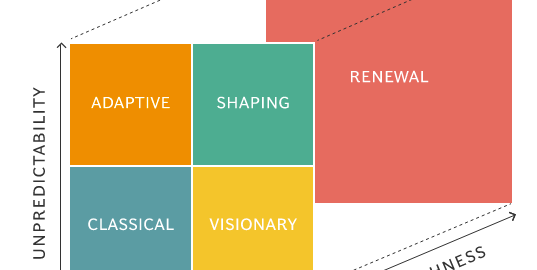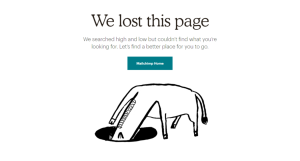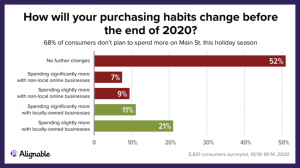
Strategy, strategy, strategy.
While strategic planning has never been easy, the framework for developing strategy was very straightforward and linear: evaluate, plan, execute, assess.
But the classic way to develop strategy is only one of many options. Last week I shared a new take on strategy in the form of exponential organizations — organizations that grow returns exponentially versus the typical linear return on investment.
Today I bring you a set of strategies developed by BCG (Boston Consulting Group), which many of you know from the classic BCG matrix you undoubtedly learned in marketing class. Called the Strategy Palette, businesses that understand the strategic options contained in an environment bounded by change (predictability) and the ability to influence change (malleability) outperform other businesses by 4 – 8% according to a study by BCG (as measured by shareholder value — which I happen to think is the wrong metric, but it’s embedded in much of strategic thinking). Harshness of the environment is also included to round out the optional strategic environments.
Now, 4 or 8% doesn’t sound like much. But, when you’re talking about a billion dollar organization, 8% is $ 80 million, which isn’t chump change. And, for certain organizations, exponential growth is possible.
Above, you see the quadrants making up the strategic palette and below is a video demonstrating the concept produced by BCG.
The strategy of strategy
BCG strategists published a new book on the strategy of strategy: Your Strategy Needs a Strategy: How to Choose and Execute the Right Approach![]() .
.
Take a look at the table below to see how BCG classifies different industries based on the strategy palette:

Most of what you learned in B-school or read in business books represents the classic quadrant reflecting predictability and low malleability. It’s here that strategic thinking including Porter’s 5 forces, blue oceans, and the growth/ share matrix (another name for the BCG matrix) fit.
Using the wrong strategy with a particular environment can lead to disaster.
Think about what happened at Apple when they brought in John Scully from Pepsi as CEO. Scully did a great job for Pepsi (operating in a classical strategic corner), but applying similar strategies to Apple, which operated in the shaping corner almost lead to disaster not just for the company, but its consumers. Without Apple to challenge the status quo in the computer industry, we wouldn’t have tablets, mobile apps, or other innovations.
Let’s think about how strategy is different in different strategic environments.
Adaptive environments
Adaptive environments are more the norm than the exception today where classical environments are (according to BCG):
Becoming less and less true where global competition, technological innovation, social feedback loops, and economic uncertainty combine to make the environment radically and persistently unpredictable. In such an environment, a carefully crafted classical strategy may become obsolete within months or even weeks.
This is why I like to quote a line from a movie to the effect of:
A good plan today is better than a great plan tomorrow!
Taking weeks or months to develop a strategy is just too long.
Even in the stodgy CPG industry (consumer packaged goods), the pace of change is now staggering. As cited in the book Exponential Organizations, established CPG companies struggle to get a new product to market in less than a year, while upstarts can do it in less than a month!
Strategic planning in an adaptive environment requires flexibility, not efficiency — flexible goals, flexible products, flexible resources, and the ability to respond quickly to change. Long-term planning is not only useless, it shackles tactics to an obsolete paradigm.
Marrying strategy with operations allows firms operating in adaptive environments to test out products using flexible production facilities or contract manufacturing before committing to a strategic course of action — or instead of ever committing.
Visionary
Visionaries are not only adept at predicting the future, they have the will to change to take advantage of the future. Amazon is a good example. In the late 1990’s when dotcoms were failing by the hundreds, Amazon kept investing in warehouses even though it resulted in massive losses for the company. If you were around then, you heard predictions that Amazon would fail when its executives predicted it would be 5 years before they turned a profit.
But, that was the right strategy.
Amazon recognized what other dotcoms failed to — that ecommerce wasn’t a “get rich quick” endeavor, but required investment to capitalize on the future.
And, they’re doing it again — investing in drones to speed delivery of packages.
Why, you ask, isn’t FedEx investing in drones?
They don’t see the potential.
And, that could cost them their business.
Shaping
Software, Internet technologies, and computer gadgets operate in environments where the landscape not only changes unpredictably, but where the players themselves guide that change. Two guys working in their garage can totally disrupt and entire industry causing giant firms to fail. Look at how the giant IBM was laid low by upstarts like Dell and Apple that simply changed the rules of the game in a way that the monolithic companies couldn’t follow because they were wedded to a unwieldy, behemoth bureaucracy.
Even nibble upstarts aren’t immune to the narrow strategic thinking of classical environments. Such was the case with Apple and its strategy of incremental improvements to the Lisa computer (its main product) in the face of a changing environment rewarding innovation. Others, like Craig Barrett, former Chair of Intel, for instance, says that 90% of December profits come from products that didn’t exist in January.
BCG defines the difference between shaping and adaptive strategy as:
But unlike adapters, shapers focus beyond the boundaries of their own company, often by rallying a formidable ecosystem of customers, suppliers, and/or complementors to their cause by defining attractive new markets, standards, technology platforms, and business practices. They propagate these through marketing, lobbying, and savvy partnerships.
Openness is a key element of shaping organizational strategy. Hiring innovative thinkers and giving them the resources to innovate, partnering with other organizations to develop complementary products, and acquiring organizations with products that enhance your core product keeps a firm relevant in a shaping environment.
Contrast Facebook with Twitter and you’ll see a disaster on the horizon. Facebook develops new functionality and responds to user concerns through a combination of innovations invented internally or through partnerships with other firms like King and Match 3 who create the addicting games trending in your timeline. In contrast, Twitter shuts down potential collaborators with a “not invented here” mentality. For instance, Twitter recently shut down access to Meerkat (streaming video on Twitter) and several data firms selling the “firehose” of data generated by all those Tweets in response to acquisitions of competitors to these products. Time will tell which of these will prove optimal, but, if history is any predictor, Twitter will go into decline just as MySpace did in the Facebook space.
(278)






